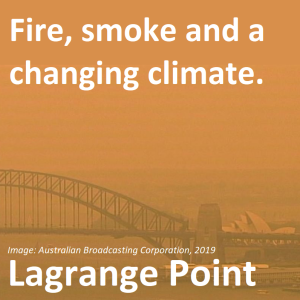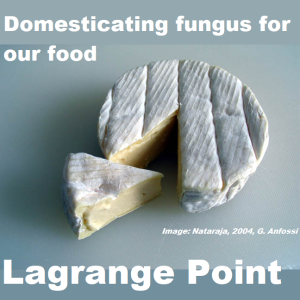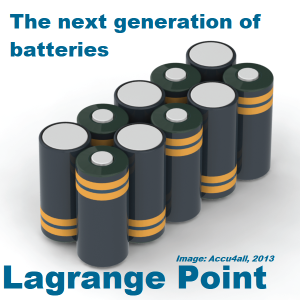Episodes

Monday Aug 24, 2020
Episode 393 - Microbial life in a teaspoon of the ocean
Monday Aug 24, 2020
Monday Aug 24, 2020
Life in the ocean is more than just fish, whales and squid, it goes down to a microbial level. We can learn a lot about the health of a whole reef system by studying microbial life in the water. Just one teaspoon of the ocean contains thousands of unique microbes. The ocean currents carry and mix ocean microbes. What makes a healthy reef? Well take a look at the microbes. How can nutrient and soil runoff damage a reef?
- Maria G. Pachiadaki, Julia M. Brown, Joseph Brown, Oliver Bezuidt, Paul M. Berube, Steven J. Biller, Nicole J. Poulton, Michael D. Burkart, James J. La Clair, Sallie W. Chisholm, Ramunas Stepanauskas. Charting the Complexity of the Marine Microbiome through Single-Cell Genomics. Cell, 2019; 179 (7): 1623 DOI: 10.1016/j.cell.2019.11.017
- Laura Weber, Patricia González‐Díaz, Maickel Armenteros, Víctor M. Ferrer, Fernando Bretos, Erich Bartels, Alyson E. Santoro, Amy Apprill. Microbial signatures of protected and impacted Northern Caribbean reefs: changes from Cuba to the Florida Keys. Environmental Microbiology, 2019; DOI: 10.1111/1462-2920.14870

Monday Aug 03, 2020
Episode 390 - Cool fabrics, melting ice and recycling e-waste
Monday Aug 03, 2020
Monday Aug 03, 2020
From cool fabrics, to melting ice and recycling e-waste. How can a fabric let air through, but keep water out? Clothing that is breathable, water resistant and thermally efficient hits the sweet spot of a super fabric. Making clothes more efficient at cooling but also self cleaning can reduce our reliance on air conditioning. Using electricity and some polymers we can spin up some new cool clothing fabrics. Melting ice in your frozen over freezer can be made easier with biphillic materials. Materials that both hate and love water at the same time, can help melt ice and make heater exchangers more efficient. Recycling e-waste can be tricky, but what if we could use the by-products to make new, stronger coatings for steel? Turning e-waste into a steel boosting coating.
- Rumana Hossain, Veena Sahajwalla. Material Microsurgery: Selective Synthesis of Materials via High-Temperature Chemistry for Microrecycling of Electronic Waste. ACS Omega, 2020; 5 (28): 17062 DOI: 10.1021/acsomega.0c00485
- Xi Yu, Yang Li, Xianfeng Wang, Yang Si, Jianyong Yu, Bin Ding. Thermoconductive, Moisture-Permeable, and Superhydrophobic Nanofibrous Membranes with Interpenetrated Boron Nitride Network for Personal Cooling Fabrics. ACS Applied Materials & Interfaces, 2020; 12 (28): 32078 DOI: 10.1021/acsami.0c04486
- Yashraj Gurumukhi, Shreyas Chavan, Soumyadip Sett, Kalyan Boyina, Srivasupradha Ramesh, Peter Sokalski, Kirk Fortelka, Maury Lira, Deokgeun Park, Juo-Yun Chen, Shreyas Hegde, Nenad Miljkovic. Dynamic Defrosting on Superhydrophobic and Biphilic Surfaces. Matter, 2020; DOI: 10.1016/j.matt.2020.06.029

Monday Jul 27, 2020
Episode 389 - Chronic Pain, Ears, Long lasting Electrodes
Monday Jul 27, 2020
Monday Jul 27, 2020
Treating chronic pain through tiny electrodes in your ear. Can 3 phase like stimulating of nerves in your eye help treat chronic pain? Mapping out the inside of the ear in incredibly fine detail can help treat chronic pain. Fine tuning tiny electrodes inside the ear can help relieve chronic pain. Using a printer, tattoo paper and polymers to make long lasting electrodes. Flexible, thin and long lasting electrodes can make it easier to study the brain and the heart. Studying the brain over the long term just got easier with tattoo paper based electrodes.
- Babak Dabiri, Stefan Kampusch, Stefan H. Geyer, Van Hoang Le, Wolfgang J. Weninger, Jozsef Constantin Széles, Eugenijus Kaniusas. High-Resolution Episcopic Imaging for Visualization of Dermal Arteries and Nerves of the Auricular Cymba Conchae in Humans. Frontiers in Neuroanatomy, 2020; 14 DOI: 10.3389/fnana.2020.00022
- Laura M. Ferrari, Usein Ismailov, Jean-Michel Badier, Francesco Greco, Esma Ismailova. Conducting polymer tattoo electrodes in clinical electro- and magneto-encephalography. npj Flexible Electronics, 2020; 4 (1) DOI: 10.1038/s41528-020-0067-z

Monday Jul 20, 2020
Episode 388 - Cleaning, drinking and shaping water
Monday Jul 20, 2020
Monday Jul 20, 2020
Making water safe to drink, from evaporation to treatment. How do you simply evaporate water to make it safe? A piece of aluminium and a laser can hold the key to providing cheap and safe drinking water to the world. Pharmaceutical waste can build up in waster water, so how can it be treated? How can two little electrodes deal with the problem of pharmaceutical waste in water? Changing the course of a river can have huge consequences. What can we learn by studying the changes caused by the Panama Canal?
- Subhash C. Singh, Mohamed ElKabbash, Zilong Li, Xiaohan Li, Bhabesh Regmi, Matthew Madsen, Sohail A. Jalil, Zhibing Zhan, Jihua Zhang, Chunlei Guo. Solar-trackable super-wicking black metal panel for photothermal water sanitation. Nature Sustainability, 2020; DOI: 10.1038/s41893-020-0566-x
- Yassine Ouarda, Clément Trellu, Geoffroy Lesage, Matthieu Rivallin, Patrick Drogui, Marc Cretin. Electro-oxidation of secondary effluents from various wastewater plants for the removal of acetaminophen and dissolved organic matter. Science of The Total Environment, 2020; 738: 140352 DOI: 10.1016/j.scitotenv.2020.140352
- Jorge Salgado, María I. Vélez, Catalina González-Arango, Neil L. Rose, Handong Yang, Carme Huguet, Juan S. Camacho, Aaron O'Dea. A century of limnological evolution and interactive threats in the Panama Canal: Long-term assessments from a shallow basin. Science of The Total Environment, 2020; 729: 138444 DOI: 10.1016/j.scitotenv.2020.138444

Monday Jun 29, 2020
Episode 385 - Understanding what makes water stick together
Monday Jun 29, 2020
Monday Jun 29, 2020
What seems simple but it's deceptively complex. What makes water molecules stick together, or ice to float on top? Water has many mysteries, like ice floating on liquid. The key lies in the energy distribution. Shooting super high frequency lasers at water can help figure out what makes ice float or water stick together. Cheap and efficient ways to clean water is essential for saving lives across the globe. How can cyrstaline sponges help soak up bad chemicals like hexavalent chromium.
- Martina Havenith-Newen, Raffael Schwan, Chen Qu, Devendra Mani, Nitish Pal, Gerhard Schwaab, Joel M. Bowman, Gregory Tschumper. Observation of the low frequency spectrum of water trimer as a sensitive test of the water trimer potential and the dipole moment surface. Angewandte Chemie International Edition, 2020; DOI: 10.1002/anie.202003851
- Bardiya Valizadeh, Tu N. Nguyen, Stavroula Kampouri, Daniel T. Sun, Mounir D. Mensi, Kyriakos Stylianou, Berend Smit, Wendy L. Queen. A novel integrated Cr(vi) adsorption–photoreduction system using MOF@polymer composite beads. Journal of Materials Chemistry A, 2020; DOI: 10.1039/d0ta01046d

Monday Jun 22, 2020
Episode 384 - Plants regenerating and fighting off invaders
Monday Jun 22, 2020
Monday Jun 22, 2020
How do plants manage to recover from damage or fungal attacks? What happens when you shoot a laser at some cress? Studying the way plants respond to damage helps us understand their regeneration methods. Plant cells can regenerate to recover from damage, but what controls this process? Fighting off a fungal invasion means an arms race between plants and fungus. Plants like cabbage use a special mustard oil bomb to fight back against fungal invaders. Fungal invaders like white mold can render even the most sophisticate plant defences useless.
- Lukas Hoermayer, Juan Carlos Montesinos, Petra Marhava, Eva Benková, Saiko Yoshida, Jiří Friml. Wounding-induced changes in cellular pressure and localized auxin signalling spatially coordinate restorative divisions in roots. Proceedings of the National Academy of Sciences, 2020; 202003346 DOI: 10.1073/pnas.2003346117
- Jingyuan Chen, Chhana Ullah, Michael Reichelt, Franziska Beran, Zhi-Ling Yang, Jonathan Gershenzon, Almuth Hammerbacher, Daniel G. Vassão. The phytopathogenic fungus Sclerotinia sclerotiorum detoxifies plant glucosinolate hydrolysis products via an isothiocyanate hydrolase. Nature Communications, 2020; 11 (1) DOI: 10.1038/s41467-020-16921-2

Monday May 11, 2020
Episode 378 - Maple Syrup Golden tongues and antioxidants
Monday May 11, 2020
Monday May 11, 2020
Taste testing maple syrup and long lasting antioxidants. How do you judge the taste of something as complex as maple syrup? How can a golden tongue help find gold, silver and bronze maple syrups? Antioxidants can keep food fresh and wounds safe, so how can they be made long lasting? Tannic acid often found in wines can make great antioxidants, but how to make their chemical effect long lasting? Fine woven meshes embedded with antioxidants can help flexible wrap food and wounds to keep them safe.
- Simon Forest, Trevor Théorêt, Julien Coutu, Jean-Francois Masson. A high-throughput plasmonic tongue using an aggregation assay and nonspecific interactions: classification of taste profiles in maple syrup. Analytical Methods, 2020; DOI: 10.1039/C9AY01942A
- Adwait Gaikwad, Hanna Hlushko, Parvin Karimineghlani, Victor Selin, Svetlana A. Sukhishvili. Hydrogen-Bonded, Mechanically Strong Nanofibers with Tunable Antioxidant Activity. ACS Applied Materials & Interfaces, 2020; 12 (9): 11026 DOI: 10.1021/acsami.9b23212

Monday Apr 20, 2020
Episode 375 - Solar Panels that work at night and on greenhouses
Monday Apr 20, 2020
Monday Apr 20, 2020
From solar panels on greenhouses to ones that work at night. How can you use radiant heat to make a solar panel work at night? Is there a way to harness energy from the sun even at night? Can you cover a greenhouse with solar panels without destroying your crops? What's the tipping point for harvesting solar energy for your greenhouse? Balancing the light needs of solar panels and of crops in a greenhouse. How does the photosynthesis process know which path to take? Shinning a light on the photosynthetic process.
- Tristan Deppe, Jeremy N. Munday. Nighttime Photovoltaic Cells: Electrical Power Generation by Optically Coupling with Deep Space. ACS Photonics, 2019; 7 (1): 1 DOI: 10.1021/acsphotonics.9b00679
- Eshwar Ravishankar, Ronald E. Booth, Carole Saravitz, Heike Sederoff, Harald W. Ade, Brendan T. O’Connor. Achieving Net Zero Energy Greenhouses by Integrating Semitransparent Organic Solar Cells. Joule, 2020; DOI: 10.1016/j.joule.2019.12.018
- Philip D. Laible, Deborah K. Hanson, James C. Buhrmaster, Gregory A. Tira, Kaitlyn M. Faries, Dewey Holten, Christine Kirmaier. Switching sides—Reengineered primary charge separation in the bacterial photosynthetic reaction center. Proceedings of the National Academy of Sciences, 2020; 117 (2): 865 DOI: 10.1073/pnas.1916119117

Monday Apr 13, 2020
Episode 374 - Lasers, Metal and Insect wings vs Bacteria
Monday Apr 13, 2020
Monday Apr 13, 2020
Taking the fight to bacteria with lasers, metal and insect wings. How can lasers help make a material into a bacteria destroyer? Metal in fantasy has demon slaying properties, but how can it help fight bacteria? What can we learn from insect wings to help make safer implants? What is it about silver that makes it good for killing bacteria (and werewolves). Why are metals so dangerous for bacteria? How can we treat and use metal to make medical devices safer from bacteria?
- Vidhya Selvamani, Amin Zareei, Ahmed Elkashif, Murali Kannan Maruthamuthu, Shirisha Chittiboyina, Davide Delisi, Zheng Li, Lirong Cai, Vilas G. Pol, Mohamed N. Seleem, Rahim Rahimi. Hierarchical Micro/Mesoporous Copper Structure with Enhanced Antimicrobial Property via Laser Surface Texturing. Advanced Materials Interfaces, 2020; 1901890 DOI: 10.1002/admi.201901890
- Asmaa A. Sadoon, Prabhat Khadka, Jack Freeland, Ravi Kumar Gundampati, Ryan H. Manso, Mason Ruiz, Venkata R. Krishnamurthi, Suresh Kumar Thallapuranam, Jingyi Chen, Yong Wang. Silver Ions Caused Faster Diffusive Dynamics of Histone-Like Nucleoid-Structuring Proteins in Live Bacteria. Applied and Environmental Microbiology, 2020; 86 (6) DOI: 10.1128/AEM.02479-19
- J. Jenkins, J. Mantell, C. Neal, A. Gholinia, P. Verkade, A. H. Nobbs, B. Su. Antibacterial effects of nanopillar surfaces are mediated by cell impedance, penetration and induction of oxidative stress. Nature Communications, 2020; 11 (1) DOI: 10.1038/s41467-020-15471-x

Monday Apr 06, 2020
Episode 373 - Deep sea reefs, ocean vents and tiny life
Monday Apr 06, 2020
Monday Apr 06, 2020
This week we look at unlikely partnerships that help sea creatures survive and thrive. What plays a crucial role inside a reef's ecosystem that is often overlooked? What's inside fish guts that help keep a reef healthy? Just how do fish 1000s of kms away end up with the same colonies of microbes? Feel like a tasty snack but stuck in the deep ocean vents, why not methane? How do microbes help worms eat methane?
- Shana Goffredi et al. Methanotrophic bacterial symbionts fuel dense populations of deep-sea feather duster worms (Sabellida, Annelida) and extend the spatial influence of methane seepage. Science Advances, 2020 DOI: 10.1126/sciadv.aay8562
- Jarrod J. Scott, Thomas C. Adam, Alain Duran, Deron E. Burkepile, Douglas B. Rasher. Intestinal microbes: an axis of functional diversity among large marine consumers. Proceedings of the Royal Society B: Biological Sciences, 2020; 287 (1924): 20192367 DOI: 10.1098/rspb.2019.2367

Monday Mar 30, 2020
Episode 372 - Flexible and wearable electronics
Monday Mar 30, 2020
Monday Mar 30, 2020
How can we make flexible electronics for our clothing? What does it take to make a screen that's flexible without relying on plastics? What aquatic by product can help make biodegradable, flexible electronics? Why do your towels go hard when you dry them in the sun? What happens on cotton fibres to make them stiffen up in the sun? How does fabric softener work - we're really not sure.
- Nara Kim, Samuel Lienemann, Ioannis Petsagkourakis, Desalegn Alemu Mengistie, Seyoung Kee, Thomas Ederth, Viktor Gueskine, Philippe Leclère, Roberto Lazzaroni, Xavier Crispin, Klas Tybrandt. Elastic conducting polymer composites in thermoelectric modules. Nature Communications, 2020; 11 (1) DOI: 10.1038/s41467-020-15135-w
- Xiaopan Zhang, Tengyang Ye, Xianghao Meng, Zhihui Tian, Lihua Pang, Yaojie Han, Hai Li, Gang Lu, Fei Xiu, Hai-Dong Yu, Juqing Liu, Wei Huang. Sustainable and Transparent Fish Gelatin Films for Flexible Electroluminescent Devices. ACS Nano, 2020; DOI: 10.1021/acsnano.9b09880
- Takako Igarashi, Masato Hoshi, Koichi Nakamura, Takeshi Kaharu, Ken-ichiro Murata. Direct Observation of Bound Water on Cotton Surfaces by Atomic Force Microscopy and Atomic Force Microscopy–Infrared Spectroscopy. The Journal of Physical Chemistry C, 2020; 124 (7): 4196 DOI: 10.1021/acs.jpcc.0c00423

Monday Feb 24, 2020
Episode 367 - Sustainable and green Chemistry
Monday Feb 24, 2020
Monday Feb 24, 2020
Making chemistry green and sustainable, from cheaper catalyst to sorting solvents. How can you make catalysts cheaper and re-usable? Is there a cheaper catalyst to breakdown CO2? How can we make a circular carbon economy? Solvents play an important role in chemistry so how do you greenly find the right match? Green chemistry can be made more efficient using CO2.
- Youngdong Song, Ercan Ozdemir, Sreerangappa Ramesh, Aldiar Adishev, Saravanan Subramanian, Aadesh Harale, Mohammed Albuali, Bandar Abdullah Fadhel, Aqil Jamal, Dohyun Moon, Sun Hee Choi, Cafer T. Yavuz. Dry reforming of methane by stable Ni–Mo nanocatalysts on single-crystalline MgO. Science, 2020; 367 (6479): 777 DOI: 10.1126/science.aav2412
- Suyong Han, Keshav Raghuvanshi, Milad Abolhasani. Accelerated Material-Efficient Investigation of Switchable Hydrophilicity Solvents for Energy-Efficient Solvent Recovery. ACS Sustainable Chemistry & Engineering, 2020; DOI: 10.1021/acssuschemeng.9b07304

Monday Jan 27, 2020
Episode 363 - Mysteries from underwater volcanoes
Monday Jan 27, 2020
Monday Jan 27, 2020
There are mysterious things lurking at the bottom of the ocean, from underwater volcanoes to mysterious graphite. Where did a pumice raft floating across the Pacific come from? Why is a raft of pumice larger than Manhattan heading to Australia? What can we learn by studying petit-spot volcanoes underneath the ocean? What connects young volcanoes with the motion of the tectonic plates? What roll do hydrothermal vents play in the carbon cycle? Where does all this graphite in the oceans come from?
- Philipp A. Brandl, Florian Schmid, Nico Augustin, Ingo Grevemeyer, Richard J. Arculus, Colin W. Devey, Sven Petersen, Margaret Stewart, Heidrun Kopp, Mark D. Hannington. The 6–8 Aug 2019 eruption of ‘Volcano F’ in the Tofua Arc, Tonga. Journal of Volcanology and Geothermal Research, 2019; 106695 DOI: 10.1016/j.jvolgeores.2019.106695
- Naoto Hirano, Shiki Machida, Hirochika Sumino, Kenji Shimizu, Akihiro Tamura, Taisei Morishita, Hideki Iwano, Shuhei Sakata, Teruaki Ishii, Shoji Arai, Shigekazu Yoneda, Tohru Danhara, Takafumi Hirata. Petit-spot volcanoes on the oldest portion of the Pacific plate. Deep Sea Research Part I: Oceanographic Research Papers, 2019; 154: 103142 DOI: 10.1016/j.dsr.2019.103142
- Harry MacKay, C. Anthony Scott, Jack D. Duryea, Maria S. Baker, Eleonora Laritsky, Amanda E. Elson, Theodore Garland, Marta L. Fiorotto, Rui Chen, Yumei Li, Cristian Coarfa, Richard B. Simerly, Robert A. Waterland. DNA methylation in AgRP neurons regulates voluntary exercise behavior in mice. Nature Communications, 2019; 10 (1) DOI: 10.1038/s41467-019-13339-3

Monday Dec 30, 2019
Episode 359 - Life surviving on freezing planets, faint suns and meteorites
Monday Dec 30, 2019
Monday Dec 30, 2019
What can bacteria from an iron ore rich lake tell us about life on early earth? Have scientists finally solved a Carl Sagan paradox about life on early earth? When the earth was young, so was the sun, and that meant less light and heat. How did early life on earth survive if there was not enough sunlight to keep it warm? How did iron ore eating and secreting bacteria help lead to widespread life on our planet? How did micro organisms get enough oxygen to survive when the entire planet was frozen over? What can iron ore deposits tell us about life surviving when the entire planet was frozen over? Can life survive on a meteorite, the answer is surprising. How can a microbe be more suited to life on a meteorite than on earth?
- Katharine J. Thompson, Paul A. Kenward, Kohen W. Bauer, Tyler Warchola, Tina Gauger, Raul Martinez, Rachel L. Simister, Céline C. Michiels, Marc Llirós, Christopher T. Reinhard, Andreas Kappler, Kurt O. Konhauser, Sean A. Crowe. Photoferrotrophy, deposition of banded iron formations, and methane production in Archean oceans. Science Advances, 2019; 5 (11): eaav2869 DOI: 10.1126/sciadv.aav2869
- Maxwell A. Lechte, Malcolm W. Wallace, Ashleigh van Smeerdijk Hood, Weiqiang Li, Ganqing Jiang, Galen P. Halverson, Dan Asael, Stephanie L. McColl, Noah J. Planavsky. Subglacial meltwater supported aerobic marine habitats during Snowball Earth. Proceedings of the National Academy of Sciences, 2019; 201909165 DOI: 10.1073/pnas.1909165116
- Tetyana Milojevic, Denise Kölbl, Ludovic Ferrière, Mihaela Albu, Adrienne Kish, Roberta L. Flemming, Christian Koeberl, Amir Blazevic, Ziga Zebec, Simon K.-M. R. Rittmann, Christa Schleper, Marc Pignitter, Veronika Somoza, Mario P. Schimak, Alexandra N. Rupert. Exploring the microbial biotransformation of extraterrestrial material on nanometer scale. Scientific Reports, 2019; 9 (1) DOI: 10.1038/s41598-019-54482-7

Monday Dec 23, 2019
Episode 358 - Wildfires, climate change, smog and charcoal
Monday Dec 23, 2019
Monday Dec 23, 2019
As the climate changes, wildfires become more common and more dangerous. Smoke clouds from wildfires can linger for weeks, but what chemistry changes inside the smog? Aerosols amongst other particles lurk inside wildfire smoke. How do we study the changes in wildfire smoke; by flying planes through the plumes. How do wildfires impact the CO2 emissions of a region? Can wildfires help store carbon through charcoal? What can charred biomass to do help capture carbon?
- Kouji Adachi, Arthur J. Sedlacek, Lawrence Kleinman, Stephen R. Springston, Jian Wang, Duli Chand, John M. Hubbe, John E. Shilling, Timothy B. Onasch, Takeshi Kinase, Kohei Sakata, Yoshio Takahashi, Peter R. Buseck. Spherical tarball particles form through rapid chemical and physical changes of organic matter in biomass-burning smoke. Proceedings of the National Academy of Sciences, 2019; 201900129 DOI: 10.1073/pnas.1900129116
- Matthew W. Jones, Cristina Santín, Guido R. van der Werf, Stefan H. Doerr. Global fire emissions buffered by the production of pyrogenic carbon. Nature Geoscience, 2019; DOI: 10.1038/s41561-019-0403-x

Monday Nov 18, 2019
Monday Nov 18, 2019
Plants play an important role in our environment, yet there is still so much more to understand. We often think of nature as a zero sum game, but older and younger plants can collaborate. When surviving in a harsh environment, the best results occur when old and young plants grow together. Photosynthesis seems simple, but understanding the intricacies of the mechanisms can help us boost crop yields. Regulating the amount of photosynthesis can help plants survive or thrive in changing climates. How do boreal forests help capture nitrogen from the air? What does an odd metal have to do with forests in Canada storing nitrogen?
- Alicia Montesinos-Navarro, Isabelle Storer, Rocío Perez-Barrales. Benefits for nurse and facilitated plants emerge when interactions are considered along the entire life-span. Perspectives in Plant Ecology, Evolution and Systematics, 2019; 41: 125483 DOI: 10.1016/j.ppees.2019.125483
- Lorna A. Malone, Pu Qian, Guy E. Mayneord, Andrew Hitchcock, David A. Farmer, Rebecca F. Thompson, David J. K. Swainsbury, Neil A. Ranson, C. Neil Hunter, Matthew P. Johnson. Cryo-EM structure of the spinach cytochrome b6 f complex at 3.6 Å resolution. Nature, 2019; DOI: 10.1038/s41586-019-1746-6
- Princeton University. (2019, November 11). Nature's backup plan for converting nitrogen into plant nutrients. ScienceDaily. Retrieved November 15, 2019 from www.sciencedaily.com/releases/2019/11/191111180100.htm

Monday Oct 28, 2019
Episode 350 - Developing, tracking, recycling new materials
Monday Oct 28, 2019
Monday Oct 28, 2019
Smart phones, computers, televisions and even children's toys are part of what makes our modern world so exciting. But these often rely on plastics and rare earth metals which are hard to recycle. Are there efficient ways to capture all those rare earth metals? How are rare earth metals in old phones recycled today, and can we make it better? Knowing which bin to put plastic in is difficult, so what if there was a more universal way to recycle plastics? How does turning plastic into a gas with the help of steam help create a circular plastic economy? How can some steam power help crack plastics back into their most basic forms? Is it possible to recycle plastics without to build whole new plastic refineries? Regulation is often playing catch up to making materials safe. Are the latest generation of 'safe' fire retardants any safer than those that came before?
References:
Robert F. Higgins, Thibault Cheisson, Bren E. Cole, Brian C. Manor, Patrick J. Carroll, Eric J Schelter. Magnetic Field Directed Rare-Earth Separations. Angewandte Chemie International Edition, 2019; DOI: 10.1002/anie.201911606
Arlene Blum, Mamta Behl, Linda S. Birnbaum, Miriam L. Diamond, Allison Phillips, Veena Singla, Nisha S. Sipes, Heather M. Stapleton, Marta Venier. Organophosphate Ester Flame Retardants: Are They a Regrettable Substitution for Polybrominated Diphenyl Ethers? Environmental Science & Technology Letters, 2019; DOI: 10.1021/acs.estlett.9b00582
Henrik Thunman, Teresa Berdugo Vilches, Martin Seemann, Jelena Maric, Isabel Cañete Vela, Sébastien Pissot, Huong N.T. Nguyen. Circular use of plastics-transformation of existing petrochemical clusters into thermochemical recycling plants with 100% plastics recovery. Sustainable Materials and Technologies, 2019; 22: e00124 DOI: 10.1016/j.susmat.2019.e00124

Monday Oct 21, 2019
Episode 349 - Domesticating fungus for our food
Monday Oct 21, 2019
Monday Oct 21, 2019
Humans have been using micro-organisms like fungus and bacteria to help improve our food for millennia. Can we tame new wild species of fungus to help create new types of our favourite foods like cheese? Penicillin is mostly known for antibiotics but it also helps give Camembert its particular taste. What causes cheese to rapidly tame wild strains of fungus? We are not the only ones who use microbes to help our food. Ants help stop disease from destroying plants by spreading their own antibiotics. Ant base antibiotics help stop plant pathogens. Sometimes bacteria don't fight against each other but rather team up and work together. Survival of kindest rules for bacteria, which helps different strains work together to survive.
References:
- Bodinaku, I., Shaffer, J., Connors, A. B., Steenwyk, J. L., Biango-Daniels, M. N., Kastman, E. K., … Wolfe, B. E. (2019). Rapid Phenotypic and Metabolomic Domestication of Wild Penicillium Molds on Cheese. MBio, 10(5). doi: 10.1128/mbio.02445-19
- Joachim Offenberg, Christian Damgaard. Ants suppressing plant pathogens: a review. Oikos, 2019; DOI: 10.1111/oik.06744
- Wenzheng Liu, Samuel Jacquiod, Asker Brejnrod, Jakob Russel, Mette Burmølle, Søren J. Sørensen. Deciphering links between bacterial interactions and spatial organization in multispecies biofilms. The ISME Journal, 2019; DOI: 10.1038/s41396-019-0494-9

Monday Oct 14, 2019
Episode 348 - More efficient Lithium-Ion batteries and Organic Batteries
Monday Oct 14, 2019
Monday Oct 14, 2019
We launch from the Nobel Prize for Chemistry 2019 into current battery research and development. Creating the ubiquitous Lithium Ion battery took decades of collaborative research across the globe. How are scientists working together today to make the new generation of batteries? Can we improve LI batteries with new electrolyte mixes? How can we use Silicon instead of graphite in our batteries to give them a boost? Is it possible to make an organic recyclable battery? How can we use proteins and peptides to make organic batteries? Can we make batteries without damaging the environment?
References:
- Nobel Foundation. (2019, October 9). Nobel Prize in Chemistry 2019: Lithium-ion batteries. ScienceDaily. Retrieved October 11, 2019 from www.sciencedaily.com/releases/2019/10/191009082508.htm
- Binghong Han, Chen Liao, Fulya Dogan, Stephen E. Trask, Saul H. Lapidus, John T. Vaughey, Baris Key. Using Mixed Salt Electrolytes to Stabilize Silicon Anodes for Lithium-Ion Batteries via in Situ Formation of Li–M–Si Ternaries (M = Mg, Zn, Al, Ca). ACS Applied Materials & Interfaces, 2019; 11 (33): 29780 DOI: 10.1021/acsami.9b07270
- American Chemical Society. (2019, August 26). Producing protein batteries for safer, environmentally friendly power storage. ScienceDaily. Retrieved October 12, 2019 from www.sciencedaily.com/releases/2019/08/190826092322.htm5

Monday Oct 07, 2019
Episode 347 - Capturing carbon with better farms and forests
Monday Oct 07, 2019
Monday Oct 07, 2019
Capturing carbon is important for helping offset CO2 emissions and tackling climate changes. Farming has an important role to play in improving CO2 sequestration with the use of cover crops and compost. Forests are important carbon sinks too, but they are at risk releasing a lot of the trapped carbon if care is not taken to stop invasive species. Plus fertilisers have helped feed the planet but can leech out nitrogen into the environment, so how do we better manage and improve the nitrogen cycle.
- Nicole E. Tautges, Jessica L. Chiartas, Amélie C. M. Gaudin, Anthony T. O'Geen, Israel Herrera, Kate M. Scow. Deep soil inventories reveal that impacts of cover crops and compost on soil carbon sequestration differ in surface and subsurface soils. Global Change Biology, 2019; DOI: 10.1111/gcb.14762
- Songlin Fei, Randall S. Morin, Christopher M. Oswalt, Andrew M. Liebhold. Biomass losses resulting from insect and disease invasions in US forests. Proceedings of the National Academy of Sciences, 2019; 201820601 DOI: 10.1073/pnas.1820601116
- Benjamin Z. Houlton, Maya Almaraz, Viney Aneja, Amy T. Austin, Edith Bai, Kenneth G. Cassman, Jana E. Compton, Eric A. Davidson, Jan Willem Erisman, James N. Galloway, Baojing Gu, Guolin Yao, Luiz A. Martinelli, Kate Scow, William H. Schlesinger, Thomas P. Tomich, Chao Wang, Xin Zhang. A World of Cobenefits: Solving the Global Nitrogen Challenge. Earth's Future, 2019; DOI: 10.1029/2019EF001222

